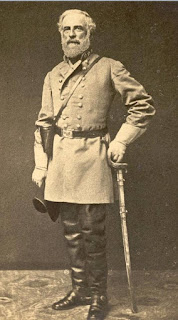The following is a re-printed post I published twelve years ago, back when this blog was in its infancy and entitled Interrogating the Project of Military History. The post was originally entitled "Drive-by Journalism," but since Rush Limbaugh long ago adopted "the drive-bys" as an epithet for mainstream media journalists, I felt obliged to change it. This is one instance, though, when the term seems entirely appropriate.
June 7 [2004] - The Society for Military History had its annual meeting on May 20-23 in Bethesda, Maryland. The Iraq war hung heavily over the whole affair, partly because the war hangs heavily over the whole country, but mostly because the conference organizers looked deliberately toward the strategic policy-making community. Bethesda, after all, is cheek by jowl next to Washington, DC.
Between one thing and another, I had not attended an SMH meeting since 1997. I went this year strictly out of a sense of professional obligation. I wasn't looking forward to it. (I wound up having a far better experience than I expected, but that's for a future entry.)
Consequently I took my sweet time getting there, stopping off at the National Road/Zane Grey Museum in eastern Ohio, then at a nearby antique store. I stuck with the Interstate until I reached Washington, Pennsylvania, at which point I decided I'd take US 40--the old National Road--down to Fort Necessity National Battlefield. I'd never been there before. It's the most poorly-chosen military position I have ever seen. I had read about it, but jeez. You look at it--a tiny stockade in a marshy meadow, too close to the woods and with a constricted field of fire--and you can't believe the guy who selected it wound up winning the war for American independence.
I didn't think beforehand about the route I'd take after visiting Fort Necessity, but it turns out that US 40 dumps you onto I-68 a few miles west of Cumberland, Maryland, which, it suddenly occurred to me, was only a few miles from Fort Ashby, West Virginia, home town of Lynndie England. These days everybody knows Pvt. England by sight if not by name: she's the female MP pointing at the genitals of Iraqi prisoners at Abu Ghraib with one hand while giving a "thumbs up" with the other. Even after a day of dawdling down the highway, I was in no hurry to reach Bethesda, so I found the exit to West Virginia's State Route 28 and drove the thirteen miles to Fort Ashby, population 1354. [1380 per the 2010 census]
The house looks remarkably like the split-levels in my own subdivision, except that the shrubs are better pruned.
My plan was to find a diner or, preferably, a bar where I could nurse a drink while eavesdropping on the local conversation. Initially I was disappointed: nothing suitable caught my eye. I was about to leave Fort Ashby when I belatedly realized that at the southwest corner of the main intersection stood a ramshackle building that looked as if it might be a bar and--yep--turned out to be just that. According to a newspaper article I found this morning on LEXIS-NEXIS, the place is called the Corner Club Saloon. But since almost nothing in the article resembled anything I saw, I give no assurances the name is correct.
I was wearing Dockers, a button-down shirt, and a sport jacket: much too dressed up for the Corner Club Saloon. But nobody called me a dude, challenged me to explain what I was doing there, or offered to rearrange my face. Instead the bartender served me one of those low-carb Michelob Ultras and said, in response to my question, that yes, he sold quite a few of them. The guys to my right continued to shoot pool. The women to my left continued an urgent discussion of something that very obviously had nothing at all to do with Iraq, Abu Ghraib, or Lynndie England.
As the minutes ticked by and I reflected with each new sip that $1.75 spent on a Michelob Ultra was $1.75 utterly wasted, I hoped against hope that a) the television above the bar from which CNN Headline News silently flickered would yield an image of the prisoner abuse scandal and, ideally, Lynndie England; and b) somebody in the bar would see it and comment on it. No such luck. But there was something homey and comfortable about the Corner Club Saloon. After a while I didn't give a hoot about my original mission. Instead I got another beer, looked over the menu, and ordered some chicken tenders for supper.
About the time that the chicken tenders arrived, the woman at my left turned to me and asked, in a neighborly sort of way that was neither challenge nor come-on, who I was. It was just her way of including me in the group. I gave her my name and said I was passing through on my way to Washington, DC. We must have chatted for five or ten minutes before she asked, inevitably, what had brought me to Fort Ashby. Any story I made up would sound so obviously made up as to be insulting, so I said, "Well, to tell you the truth, it was originally because I knew this was Lynndie England's hometown. But I don't want to speak of rope in the house of the hanged, so we don't need to talk about that."
It turned out that my new friend, whom I'll call Kitty, did in fact want to talk about that--or, more precisely, about the town's recent experience with the media. In fact, she wanted everyone within earshot to talk about it. "Hey, do you know why he's here? It's that Lynndie England story."






